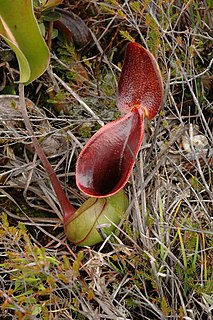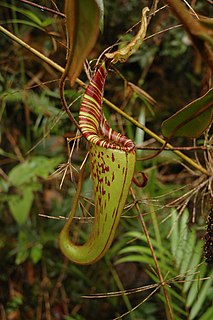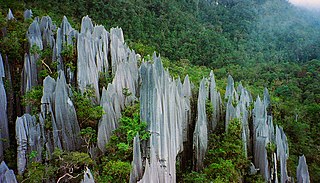| Mount Ilas Bungaan | |
|---|---|
| Highest point | |
| Elevation | c. 300 m (984 ft) |
| Geography | |
| Location | Berau, East Kalimantan, Borneo |

Mount Ilas Bungaan (Indonesian : Gunung Ilas Bungaan) is a limestone hill near Berau, East Kalimantan, Borneo. It is also known as Flowering Rock, a literal translation of its Indonesian name (ilas = rock, bungaan = flowering). [1] The hill is located "on a remote stretch of the Karangan River" [2] and its base lies at an altitude of around 300 m. [3]
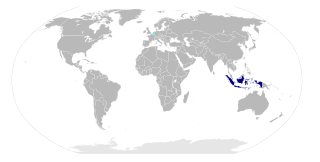
Indonesian is the official language of Indonesia. It is a standardized register of Malay, an Austronesian language that has been used as a lingua franca in the multilingual Indonesian archipelago for centuries. Indonesia is the fourth most populous nation in the world. Of its large population, the majority speak Indonesian, making it one of the most widely spoken languages in the world.

Limestone is a carbonate sedimentary rock that is often composed of the skeletal fragments of marine organisms such as coral, foraminifera, and molluscs. Its major materials are the minerals calcite and aragonite, which are different crystal forms of calcium carbonate (CaCO3). A closely related rock is dolostone, which contains a high percentage of the mineral dolomite, CaMg(CO3)2. In fact, in old USGS publications, dolostone was referred to as magnesian limestone, a term now reserved for magnesium-deficient dolostones or magnesium-rich limestones.

Berau Regency is one of the six regencies in East Kalimantan province in Indonesia. The capital is Tanjung Redeb. It has an area of 21,240 km² and a population of 179,079 at the 2010 Census.
Botanist A. J. G. Kostermans explored Mount Ilas Bungaan between September 8 and September 19, 1957, as part of an expedition to northeastern Borneo. [4] During this time, Kostermans made the first known collection of the rare pitcher plant Nepenthes campanulata , which grew on the "sand and limestone walls" [5] of the hill's 100 m high rock face. [3] He wrote the following account of his discovery: [1]
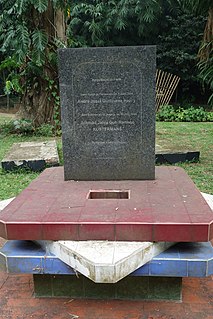
Dr. André Joseph Guillaume Henri 'Dok' Kostermans was an Indonesian botanist of Dutch ancestry. He was born in Purworejo, Java, Dutch East Indies, and educated at Utrecht University, taking his doctoral degree in 1936 with a paper on Surinamese Lauraceae.

Pitcher plants are several different carnivorous plants which have modified leaves known as pitfall traps—a prey-trapping mechanism featuring a deep cavity filled with digestive liquid. The traps of what are considered to be "true" pitcher plants are formed by specialized leaves. The plants attract and drown their prey with nectar.

Nepenthes campanulata, the bell-shaped pitcher-plant, is a tropical pitcher plant native to Borneo. It has also been reported from Palawan, the Philippines, though further field work is needed to confirm this identification.
I was working for the Forestry Department at that time in Sangkulirang and when I had finished I wanted to find out about a flowering rock, Ilas Bungaan, upriver. After 10 days walking I saw the yellowish rock for the first time. When we were there we discovered that the yellow colour was that of the leaves of a Nepenthes completely covering the steep face of the 50 m high rock. We cut a tree that fell to the rock and acted as a ladder and climbed up. The Nepenthes was not in flower or fruit, but we found caves in the rock and in the caves a couple of boat-like coffins with sculptured dog-head ends which contained decapitated skeletons.
The population of N. campanulata originally discovered on Mount Ilas Bungaan was destroyed during the widespread Borneo forest fires of 1983–1984 and the species is thus locally extinct. It has since been rediscovered in Gunung Mulu National Park in Sarawak, more than 400 km from Mount Ilas Bungaan. [2] [6] [7]
Local extinction or extirpation is the condition of a species that ceases to exist in the chosen geographic area of study, though it still exists elsewhere. Local extinctions are contrasted with global extinctions.
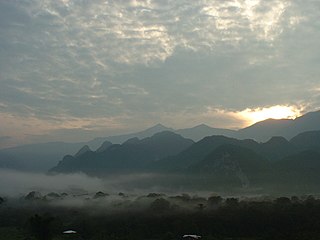
The Gunung Mulu National Park is a national park in Miri Division, Sarawak, Malaysia. It is a UNESCO World Heritage Site that encompasses caves and karst formations in a mountainous equatorial rainforest setting. The park is famous for its caves and the expeditions that have been mounted to explore them and their surrounding rainforest, most notably the Royal Geographical Society Expedition of 1977–1978, which saw over 100 scientists in the field for 15 months. This initiated a series of over 20 expeditions now named the Mulu Caves Project.
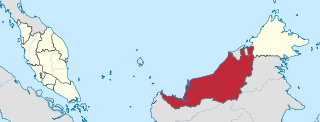
Sarawak is a state of Malaysia. The largest among the 13 states, with an area almost equal to that of Peninsular Malaysia, Sarawak is located in northwest Borneo Island, and is bordered by the Malaysian state of Sabah to the northeast, Kalimantan to the south, and Brunei in the north. The capital city, Kuching, is the largest city in Sarawak, the economic centre of the state, and the seat of the Sarawak state government. Other cities and towns in Sarawak include Miri, Sibu, and Bintulu. As of the 2015 census, the population of Sarawak was 2,636,000. Sarawak has an equatorial climate with tropical rainforests and abundant animal and plant species. It has several prominent cave systems at Gunung Mulu National Park. Rajang River is the longest river in Malaysia; Bakun Dam, one of the largest dams in Southeast Asia, is located on one of its tributaries, the Balui River. Mount Murud is the highest point in Sarawak.



